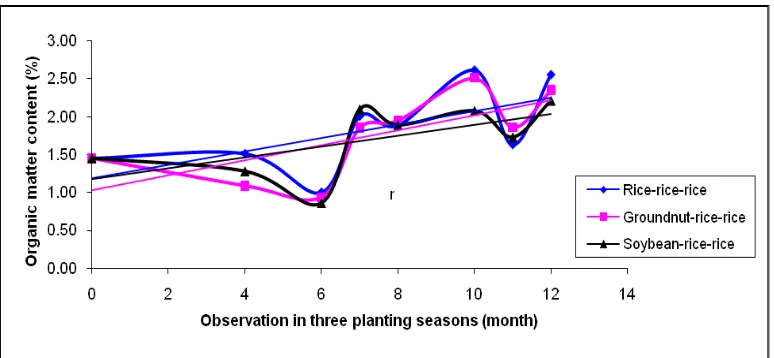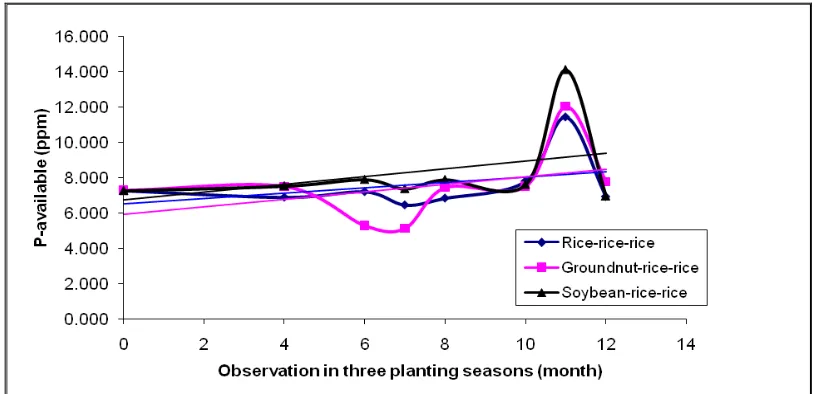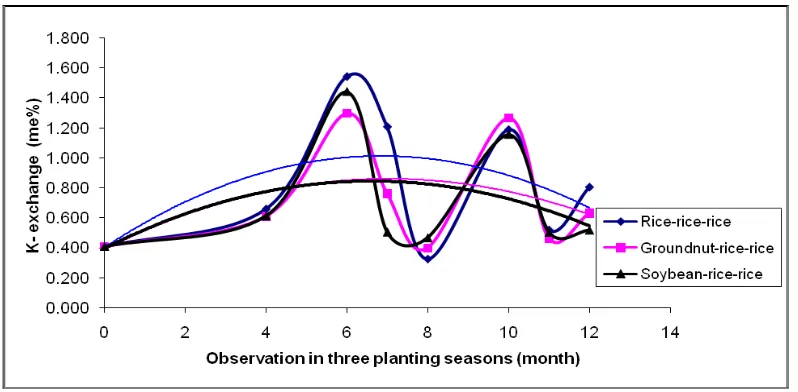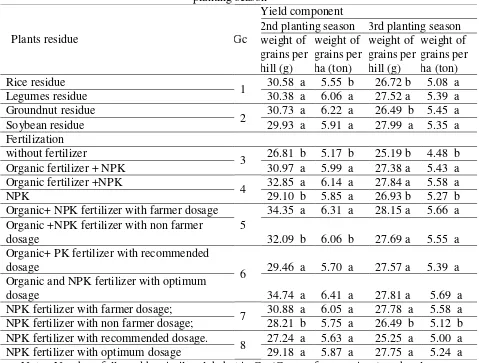ISAD_23-07_Oktavia S. Padmini
INCREASING RICE PRODUCTION BY LEGUMES SUBSTITUTING
ON CROP ROTATION AND ORGANIC FERTILIZER TO
DEVELOP AGROTOURISM
Oktavia S. Padmini
Lecture of Agriculture UPN “Veteran” Yogyakarta, Jl. SWK 104 Ringroad utara Condongcatur Yogyakarta
e-mail oktaviasarhesti@yahoo.com)
ABSTRACT
Organic agriculture is a holistic system of agricultural production and integrated, which optimize health and productivity of agro-ecosystems in nature. Experiment for crop rotation consisted of three planting seasons done at Bener Village, Ngrampal District, Sragen Regency, began in June 2005 until July 2006. The treatment of field experiment in 1st planting season was using single factor arranged in Randomized Complete Block Design, repeated three times. This experiment consisted of 3 treatments, i.e. rice, soybean and groundnut. The experiment in 2nd planting season was continued to 3rd planting season using Split Plot treatment, and three replications. Main plot was residual from legumes/paddy in the first experiment with three treatments: straw, peanuts and soybean. Sub plot was combining organic+NPK fertilizer with the seventh treatments: Organic fertilizer and recommended rate NPK, Organic fertilizer and optimum rate NPK, Organic fertilizer and farmer rate NPK, recommended rate NPK, optimum rate NPK, farmer rate NPK, with no fertilizer.
The result of the experiment showed that the role of legume can substitute rice plant on rice-rice-rice crop rotation. Groundnut-rice-rice and soybean-rice-rice rotations had N-total significantly higher and P-avalaible significantly not different, however content of organic matter, and K-exchange were significantly lower compared to on rice-rice-rice. Total rice productivity on legumes-rice-rice rotation was much higher compared to that on rice-rice-rice rotation.The role of organic fertilizer on 3rd planting season can substitute NPK fertilizer, respectively 30 %, 28 % and 32% for improving the highest yield after twice of planting season.
ISAD, Yogyakarta, INDONESIA, December 6-8, 2011
Page 2 of 10
INTRODUCTION
Increasing on food production is not separated from using modern technology such as primary seed, chemical fertilizer, pesticide, and herbicide. Recent decades (in 1967 until 1997). Indonesian government policy made priority on high yield harvest by encouraging on using inorganic fertilizer and pesticide and refused using organic ones (Adiningsih, 2006). The high yield result in fact was not last long even some problems had occurred, such as decreasing on soil fertility, especially decreasing on organic matter that turn into reducing in nutrient use efficiency, because there was ion fixation in mineral exchange complex and not available for plants. The most real effect was the plant gradually unresponsive on fertilizing (Gunadi and Bostang, 1997). Though the dosage of fertilizer had been increased, plant productivity was not in balance with supplying additional fertilizer. Negative effect is rice field had became compact and levelling of productivity. Rice productivity began in 2005 until 2007 respectively was 4.57 ton/ha. 4.62 ton/ha. 4.91 ton/ha in National grade and 5.23 ton/ha. 5.21 ton/ha 5.41 ton/ha in middle of Java (BPS. 2007). Those leveling of productivity was caused by monoculture planting rice three times in a year and applying chemical fertilizer with very high dosage in long period (Information from Deptan Sragen Regency).
Agrotourism is a system of integrated and coordinated activities for the development of agricultural tourism in relation to the preservation of the environment. Agrotourism development of organic rice has the goal of promoting agricultural products in Indonesia that provide the main attraction for visitors (Sasanti et al., 2011). Organic agriculture is a holistic system of agricultural production and integrated, which optimize health and productivity of agro-ecosystems in nature, so as to produce sufficient food and fiber, quality, and sustainable (Hoesein, 2011). One of the benefits of organic agriculture is to maintain soil quality. Maintain physical properties, chemical and biological soil is important in organic farming. Can be done by changing the cropping pattern, namely crop rotation. Proper crop rotation, mixed cropping with livestock and crop integration practices such as crop rotation, intercropping, and conservation tillage are the things that can enhance biodiversity (Palaniappan, 1985).
Planting Legumes in dry season, besides to be oriented on food diversification, its residue is effective as organic fertilizer, as soil correction material as well as nutrient sources. Straw from harvest remains and manure surrounds are very good for organic fertilizer. Using organic fertilizer and implementing precise crop rotation will increase soil organic material content as an indicator of soil fertility increasing. The high level of soil fertility positively correlates with plant growth, increasing rice yield as well as hulled rice quality (Prasad and Power, 1997).
ISAD, Yogyakarta, INDONESIA, December 6-8, 2011
Page 3 of 10
MATERIALS AND METHODS
The experiment for crop rotation consisted of three planting seasons. It was done at Bener Village, Ngrampal District, Sragen Regency, began in June 2005 until July 2006. The treatment of field experiment in 1st planting season was using single factor arranged in Randomized Complete Block Design, repeated three times with block size 5 m x 45 m. This experiment consisted of 3 treatments, i.e. rice, soybean and groundnut. Rice field experiment in 2nd planting season was continued to 3rd planting season using Split Plot treatment, was arranged in RCBD and repeated 3 times with 5 m x 6 m square size. The main block of 2nd planting season rice field experiment was buried plant residue from 1st planting season field experiment. The main block of 3rd planting season rice field experiment was the legumes/rice residue from 1st planting season and rice residue from 2nd planting season. As Sub block there was organic and NPK fertilizer consisted of seven level of treatments, i.e. 1) without fertilizer; 2) Organic and NPK fertilizer with farmer dosage; 3) Organic and NPK fertilizer with optimum dosage; 4) Organic and NPK fertilizer with recommended dosage; 5) NPK fertilizer with farmer dosage; 6) NPK fertilizer with optimum dosage; and 7) NPK fertilizer with recommended dosage.
The recommendation dosage of NPK fertilizer were 300 kg urea/ha, 150 kg SP-36/ha and 50 kg KCl/ha. Optimum dosage, NPK fertilizer was obtained from pot experiment, those were 450 kg/ha, 225 kg SP-36/ha and 100 kg KCl/ha. Farmer dosage of fertilizer, were used common local fertilizer with 600 kg urea kg/ha, 300 Kg SP-36/ha and 150 kg KCl kg/ha. Trial analysis of the diversity level of 5% is used to see the influence of each factor in both the main plot and sub plot. To know when showing the real difference between the treatments continued test of DUNCAN 5% level
RESULT
The result from the soil analysis vertisol before planting had pH (H2O) 6.64 and pH
(KCl) 5.99. Bulk density and particle density were 2.65 g/cm3 and 1.82 g/cm3. Organic matter content was low, 1.45%; ion exchange capacity was 23.75 me%, N-total 0.09% with CN ratio 9. P-available 7.23 ppm; K-exchange 0.41 me%. The content or organic fertilizer was C-organic content 16,89 %, organic matter content 26.68 %, Total of N, P, and K respectively were 1.28 %, 0.78 % and 0.86 %, CN ratio 13.
1. Organic matter
ISAD, Yogyakarta, INDONESIA, December 6-8, 2011
Page 4 of 10 Figure 1. Organic matter content in many kind of crops rotation on three planting
seasons
Regression analysis of organic matter content on three kind of crops rotation, Y (Rice-rice-rice) = 1.190 + 0.088 x; R2 = 0.400, Y (Groundnut-(Rice-rice-rice) = 1.035 + 0.098 x; R2 = 0.488 dan Y (Soybean-rice-rice) = 1.179 + 0.071 x; R2 = 0.362 were linier. It means that organic matter content each month was increased slightly, respectively 0.09%, 0.10% and 0.07%.
2. N-total
Contents of N-total in many kinds of crop rotation on three planting seasons were showed in figure 2.
ISAD, Yogyakarta, INDONESIA, December 6-8, 2011
Page 5 of 10 Regression equation ofN-total showed that Y (Rice-rice-rice) = 0.09 + 0.0005 x; Y (Groundnut-rice-rice) = 0.11 + 0.0006 x dan Y (Soybean-rice-rice) = 0.105 + 0.0021 x were flat. It means that N-total content each month was not increased.
3. P-available
Contents of P-available in many kinds of crop rotation on three planting seasons were showed in figure 3
Regression equation of P-available showed that Y (Rice-rice-rice) = 6.499 + 0.1521 X; Y (Groundnut-rice-rice) = 5.945 + 0.212X and Y (Soybean-rice-rice) = 6.746 + 0.218 X. were linier. It measn that P-available each month was increased slightly, respectively 0.152 ppm 0.212 ppm and 0.218 ppm.
Figure 3. Content of P-available in many kind of crops rotation on three planting seasons
4. K-exchange
Contents of K-exchange in many kinds of crop rotation on three planting seasons were showed in figure 4
Regression equation showed that K-exchange was Y (Rice-rice-rice) = 0.398 + 0.179 X – 0.013X2; R2 = 0.234, Y (Groundnut-rice-rice) = 0.391+ 0.134 X – 0.009 X2; R2 = 0.192 dan Y (Soybean-rice-rice) = 0.397 + 0.135 X – 0.010 X2; R2 = 0.177.
ISAD, Yogyakarta, INDONESIA, December 6-8, 2011
Page 6 of 10 Figure 4. Content of K-exchange in many kind of crops rotation on three planting
seasons
Content of N-total in groundnut-rice-rice and soybean-rice-rice rotations had significantly higher but P-avalaible significantly not different. Organic matter content, and K-exchange was significantly lower compared to on rice-rice-rice. Average of P-avalaible contents on rice-rice-rice and soybean-rice-rice rotation was increased significantly higher compared to groundnut-rice-rice.
Effect of legumes/rice residual and organic fertilizer on yield component, such as weight of grains per hill, and weight of grains per hectare in 2nd end 3rd planting season were showed on Table 2.
ISAD, Yogyakarta, INDONESIA, December 6-8, 2011
Page 7 of 10 Table 2. The weight of grains per hill, and weight of grains per hectare in 2nd and 3rd
planting season
Plants residue Gc
Yield component
2nd planting season 3rd planting season weight of
Note: Numbers followed by similar alphabet in Gc (Group of comparison) each column showed not significantly different in orthogonal contras at 95% level of confidence
DISCUSSION
By implementing organic farming crop rotation system with an organic fertilizer technology in accordance with environmental sustainability, aimed at optimizing the utilization of agricultural resources in order to obtain optimal yields a safe and sustainable. Organic rice as a good commodities to supports the concept of Agrotourism. Role of legumes as a source of organic material that increase the soil physical, soil chemical and soil biological properties. Legumes also as a source of nitrogen. Although rice after-used soils produced organic matter content is higher, but levels of N-and P-total available is lower than the legumes.
ISAD, Yogyakarta, INDONESIA, December 6-8, 2011
Page 8 of 10 Improvement of soil quality on crop rotation rice-rice-rice only limited observations of soil chemical properties. Although the legume residue is given only once in the 1nd planting season produces a lower organic matter, however the legume crop contributes N from its root nodules and mineralized residue embedded legumes produce nitrogen. Peanut residue increase levels of P-available, K-exchanged and Cation exchange Capacity (CEC). Organic fertilizers increase levels of N-total for the mineralization, that are more easily available to plants, and increase levels of available P due to the formation of complex humic Phosphat. Increased organic matter was positively correlated with increasing of CEC. In the exchange complex can release K-exchanged. Returns crop residues into the next planting increased soil fertility.
Increased productivity of legume-rice crop rotation related to the improvement of soil chemical properties, namely the treatment of residual legume in 2nd planting season 55 days produce P-available (6.03 ppm) and Cation exchange capacity (31.22%) were significantly higher than the P-available (5.62 ppm) and Cation exchange capacity (to 28.81%) in rice residue. Rice + legume residues increase organic matter (1.86%) compared with the organic matter content in the residue + rice paddy (1.57%) (Padmini, 2011). Organic matter increase the Cation exchange capacity, buffering of nutrients and nutrient balance.
CONCLUSIONS
1. Role of organic fertilizer on 3rd planting season can substitute NPK fertilizer, respectively 30 %, 28 % and 32% for improving the highest yield after twice of planting season.
2. Groundnut-rice-rice and soybean-rice-rice rotations had N-total significantly higher and P-avalaible significantly not different, however contents of organic matter, and K-exchange were significantly lower compared to on rice-rice-rice.
3. Productivity of legume-rice crop rotation was significantly higher compared to rice-rice-rice.
4. Organic farming crop rotation system with an organic fertilizer technology in accordance with environmental sustainability, aimed at optimizing the utilization of agricultural resources in order to obtain optimal yields a safe and sustainable. Organic rice as a good commodities to supports the concept of Agrotourism.
ACKNOWLEDGEMENT
Many thanks go to Prof. Dr. Ir. Tohari, M.Sc., Prof. Dr. Ir. Djoko Prajitno, M.Sc., Dr. Ir. Abdul Syukur, S.U, for promoting, giving suggestion and input during this experiment and for reading and helping this manuscript.
REFERENCES:
ISAD, Yogyakarta, INDONESIA, December 6-8, 2011
Page 9 of 10 BPS Kab. Sragen ,2007. Biro Pusat Statistik Indonesia Kabupaten Sragen
Gunadi, D. H., dan B. Radjagukguk, 1997. (Terjemahan). Teknologi dan Penggunaan Pupuk. Gadjah Mada Univ. Press. 929 p.
Hoesein, R. 2011. Konsultan LM3 Model GMM Nafiri dan pas Pelangi. Menado. Diolah oleh Kementrian Perpanian Republik Indonesia
Padmini, O. S., 2009. Peran legum dan pupuk organik dalam rotasi tanaman berbasis padi di vertisol Kecamatan Ngrampal, Kabupaten Sragen. Disertasi Program Pascasarjana Fakultas Pertanian Universitas Gadjah Mada. 325 p
Palaniappan, S. P., 1985. Cropping Systems In the Tropics. Principles and Management, Wiley Eastern Limited. 213 p.
Prasad R., and J. F. Power, 1997, Soil Fertility Management for Sustainable Agriculture. Lewis Publishers. New York. 356 p.
Sasanti, S. A., F. Ananda, M. Fadhli. 2011. Pengembangan Agrotourism Berbasiskan Ramah Lingkungan Dalam Peningkatan Kesejahteraan Masyarakat, Diversifikasi Pangan, Dan Penerapan Pertanian Modern Di Desa Muntuk, Kecamatan Dlingo, Kabupaten Bantul. PKM Institut Pertanian Bogor
Stoskopf, N. C. 1981. Understanding Crop Production. Reston Publishing Company, Inc., Reston, Virginia A Prentice-Hall Company. USA. 423 p
ISAD, Yogyakarta, INDONESIA, December 6-8, 2011



